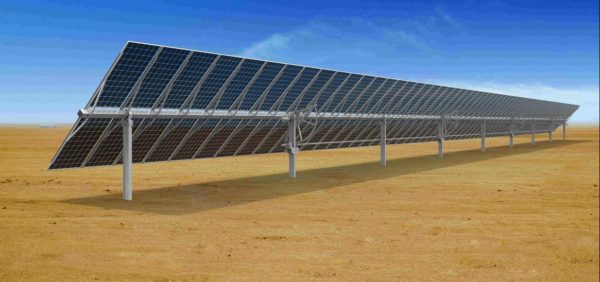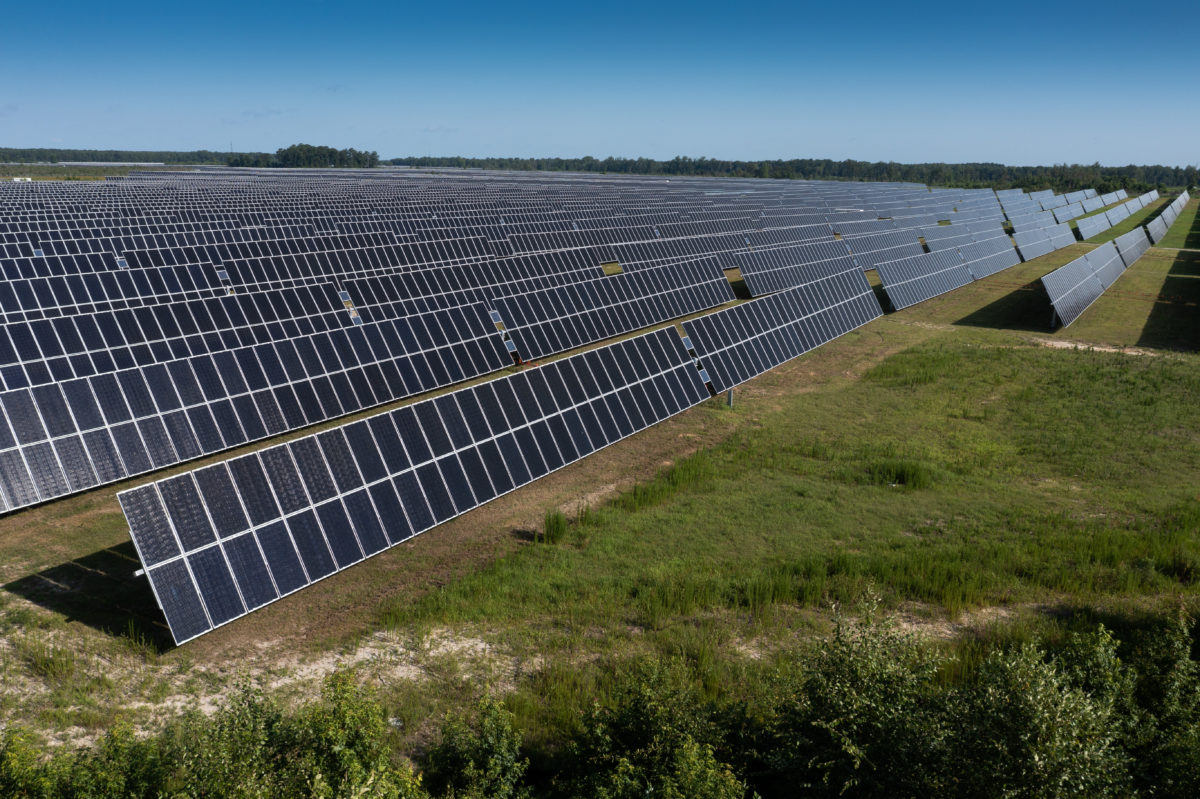As was highlighted briefly in the first entry in this series, high wind speeds, especially since the advent and subsequent adoption of large-format modules, are one of the critical variable factors limiting the overall impact that trackers can have on the solar industry.
High wind can mean sustained gusts over the course of hours – known as static wind loads – or short bursts of incredibly high-speed wind – known as dynamic wind loads. Both can be part of development considerations, and you will seldom find a site that is subject to one but not the other.
Unbending resolve
In March, FTC Solar co-authored a whitepaper with wind engineering experts RWDI and structural engineering firm Engineered Power Solutions (EPS) to highlight how the zero-degree wind stow position and proprietary dampening technology used in FTC’s Voyager SAT alleviates the effects of static and dynamic wind loading, preventing catastrophic failure and revenue loss.
Traditionally, dynamic and static load consideration has been tackled by using modest amounts of damping to raise the natural frequency that the unit can sustain above the level excited significantly by the wind by stiffening the structure known as underdamping, and to stow at a higher angles, typically 30 degrees. In an underdamped system adding more damping beyond a certain point does not have much impact on stability and the authors state that conventional wisdom has been that only a combination of stiffer structure and stowing at higher angles along with modest damping will ensure stability.
The paper found that much larger amounts of damping, overdamping, than traditionally considered create an unexpected result. This amount of damping essentially makes it impossible for practical tracker designs to become unstable even when stowed flat.
While extra damping measures increase overall structural stability, stowing modules in a flat or horizontal position during a wind event has the advantage of reducing normal static wind loads. With the solar panels held flat, the lateral forces acting on the foundation are much smaller than if that panel were vertical or at an angle tilted toward the wind. This means less force on the system overall and it substantially reduces the loads on the modules.
In a similar vein, another industry stalwart, Arctech Solar, released a new white paper outlining the opportunities presented by stowing modules at a zero-degree angle in high-wind scenarios, a solution made possible by the advent of rigid trackers, like the company’s SkyLine II 1P Tracker, developed to be rigid enough for zero-degree stowing in instances of high wind.
In the white paper, Arctech claims that a zero-degree stow angle enable projects to expand geographically into higher-intensity wind zones while preventing energy losses that would be incurred by other stow strategies and increasing energy generation and revenue a “considerable” extent.
In order to remain structurally stable during a high wind event, traditional trackers needs to be stowed at a steep tilt angle, with the tracker nose down and the front panel surface facing the wind. The wind speed threshold that triggers this reaction is called the wind stow speed, and that trigger speed has to be lower than the known point of speed where structural damage and potential for catastrophic loss is initiated.
With the onset of LFMs, trackers got longer and wider, lowering rigidity and bringing the critical wind speeds down for all tilts. As a result wind stow thresholds declined to near 12 meters per second, a relatively common speed. If trackers are forced into stow functions at such a relatively common wind speed, modules will have less tracking time, meaning less energy will be generated and levelized cost of electricity, a critical metric for the financial viability of solar projects, will be raised. For SkyLine II and any similarly-constructed rigid tracker, the the critical wind speed sits at 22 m/s, nearly doubling the parameters for wind a project can operate under.

In testing, Arctech found that its rigid tracker, stowed at zero degrees, spent just 15 hours, 0.17% of the the modeled year, in stow position, losing 204 MWh in that time, roughly 0.09% of projected generation, for a financial loss of just over $5,700. A traditional tracker with a wind threshold of 16m/s and a 30-degree stow angle spent 243 hours, 2.77% of the the modeled year, in stow position, losing 1,711MWh in that time, roughly 0.77% of projected generation, for a financial loss of almost $48,000. A hypothetical worst-case scenario with a wind threshold of 12m/s and a 45-degree stow angle spent 1,288 hours, 14.7% of the the modeled year, in stow position, losing nearly 9,300MWh in that time, roughly 4.17% of projected generation, for a financial loss of over $260,000.
Tailored solutions
Like terrain, Terrasmart sees the issue of wind load as another issue that is more than just black and white, again choosing to tackle the variable with a project dependent, site specific approach.
“I think it all comes back down to these core driving metrics for any one person or any one site, and certain people will prioritize certain things over another,” explained Dean Vukovic, the General Manager of Terrasmart’s ground mount division. “For us, with this technology and platform agnostic approach, whatever those core drivers are, we can work with you, and rapidly model out ‘Okay, here’s option B, if we prioritize low O&M costs, or option C with an extreme weather event that has a certain preference to one technology over the other.’ We can quickly model that, understand what the annual power production looks like, and then have option B and Option C, side-by-side and see what our overall impact is with various scenarios. That’s where we work on the upfront design engineering process one on one with the customer.”
Developing a system to be wind-resistant is only half the battle, however. Everybody has a plan to mitigate the wind until it starts whipping up. As Vukovic explains it, the issue is as much one of monitoring and upkeep once a project is live as it is one of modeling during development.
“We can design a system to meet whatever specific requirements are afoot,” he said. And the controls can factor into that if there’s a particular site that is experiencing some strange weather phenomenon. The software itself can be dialed to make the system operate slightly differently for certain periods of time. Maybe, during hurricane season, there’s a system down in the Carolinas that’s really proactive, and they want to throttle everything back to make sure that everything is good. We can do that over the air update pretty rapidly.”
Wind, like uneven land, is another area where Vukovic admits that using tracker may not always be the optimal solution. Because of Terrasmart’s variable mounting solutions and seemingly endless potential development scenarios enables by the company’s project modeling software, there are plenty of scenarios where racking makes the most sense.
If you’re in an area like Florida, where you have to achieve stability in 140 mile per hour wind speeds, modeling can show that fixed-tilt racking might be the better solution there. The system may lose a little bit of generation on the average day, in terms of not tracking the sun, but won’t lose on the non-average day, where 140 mile an hour winds are ripping through.
It all comes back down to these core driving metrics for any one person for any for any one site,” said Vukovic. “Certain people will prioritize certain things over another. For this technology- and platform-agnostic approach, that’s okay. Whatever those core drivers are, we can work with you and absorb those”
This content is protected by copyright and may not be reused. If you want to cooperate with us and would like to reuse some of our content, please contact: editors@pv-magazine.com.









By submitting this form you agree to pv magazine using your data for the purposes of publishing your comment.
Your personal data will only be disclosed or otherwise transmitted to third parties for the purposes of spam filtering or if this is necessary for technical maintenance of the website. Any other transfer to third parties will not take place unless this is justified on the basis of applicable data protection regulations or if pv magazine is legally obliged to do so.
You may revoke this consent at any time with effect for the future, in which case your personal data will be deleted immediately. Otherwise, your data will be deleted if pv magazine has processed your request or the purpose of data storage is fulfilled.
Further information on data privacy can be found in our Data Protection Policy.